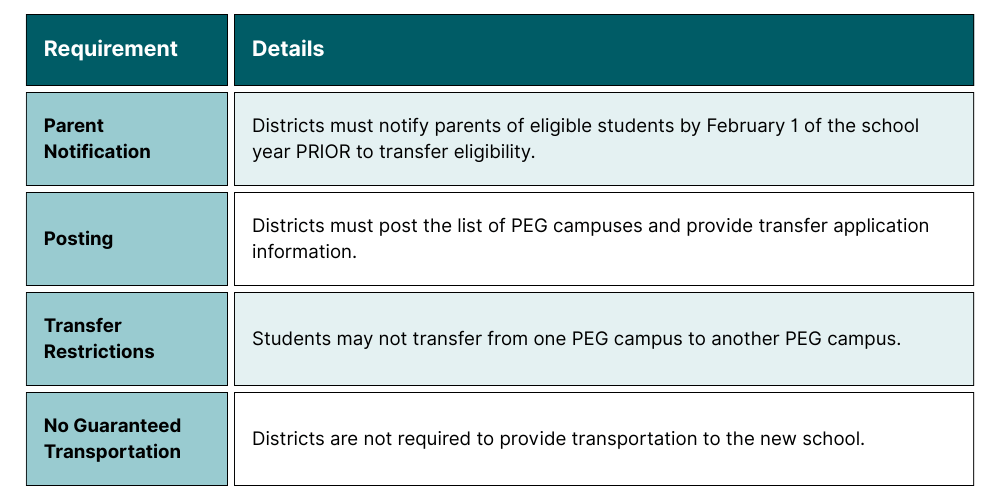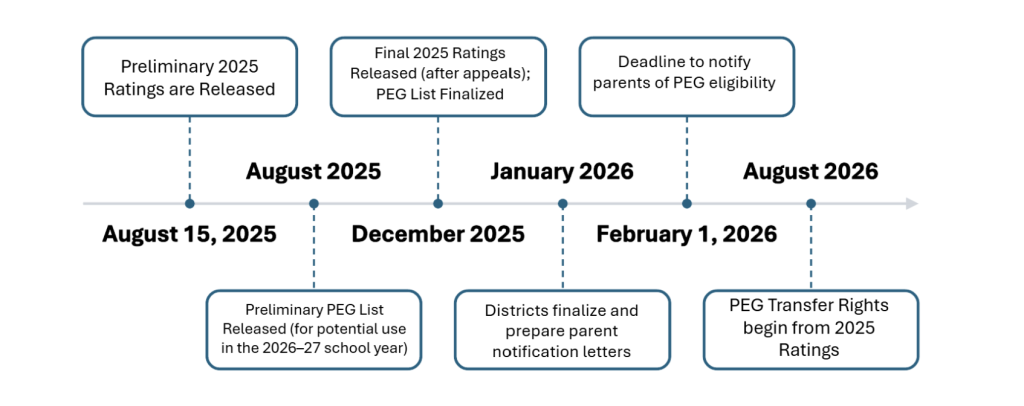Each year, the Texas Education Agency (TEA) publishes a list of campuses that fall under the Public Education Grant (PEG) program. While being labeled as a PEG campus isn’t directly tied to interventions or sanctions, this designation carries real implications, particularly around enrollment and parent communication. In this article, we’ll develop an understanding of PEG campuses for district leaders and what you need to know.
PEG Eligibility
Because the PEG list is based on the most recent accountability ratings, the campuses identified in August 2025 will determine PEG eligibility for the 2026-2027 school year.
What is the Public Education Grant?
The Texas Legislature established the Public Education Grant (PEG) program to expand educational options for students attending persistently low-performing public schools.
Under Texas Education Code Chapter 29, Subchapter G, the PEG program gives parents the right to request that their child attend a different public school (either within the same district or in another district) if their assigned campus is identified as a PEG campus.
It’s important to note that, despite its name, the PEG program is not a grant that districts apply to. It does not provide additional funding to the identified campus. Instead, PEG is a school choice program, not an accountability rating or intervention, that requires districts to take specific communication and action steps.
The only funding tied to PEG goes to receiving districts that accept transfer students from PEG campuses.
Sec. 29.202. ELIGIBILITY
(a) A student is eligible to receive a public education grant or to attend another public school in the district in which the student resides under this subchapter if the student is assigned to attend a public school campus assigned an unacceptable performance rating that is made publicly available under Section 39.054
SUBCHAPTER G. PUBLIC EDUCATION GRANT PROGRAM
What is a PEG Campus?
A campus is designated as a PEG campus when it meets the following criteria:
- The campus received an overall scaled score below 60 in the most recent available accountability ratings.
The PEG designation only applies to traditional ISD campuses. Open-enrollment charter campuses are not included on the PEG list because they are already schools of choice.
A campus is designated as a PEG Campus when it meets the following criteria:
The campus received an overall scaled score below 60 in the most recent available accountability ratings.
What Rights Does PEG Provide to Families?
Families zoned to a PEG campus are given the right to apply for a transfer to another campus in a different district. Here’s how it works:
- Interdistrict (between districts): These may be rejected or accepted by the district receiving the transfer request based on existing district policy.
- Intradistrict (within district): These requests may also be rejected or accepted based on existing district policy, although no additional funding is allotted for this type of transfer.
- UIL and Athletic Considerations: Students transferring under PEG provisions must meet eligibility rules under UIL Section 440. Transfer requests initiated solely for athletic reasons are not permitted.
Key Requirements for Districts

How the PEG Timeline Aligns With the 2025 Accountability Ratings
PEG designations are tied directly to TEA’s accountability ratings. Here’s how the timeline aligns for the 2025 cycle:

Where to Find the PEG List
The PEG list is updated annually and can be accessed on TEA’s Public Education Grant Webpage. ESC Region 13’s specialists will also contact each district with a PEG designation to ensure all questions are answered and provide guidance along the way.
TEA publishes a PEG Frequently Asked Questions (FAQ) resource each year, where district leaders can find answers to the most common questions.
Final Thoughts
While PEG isn’t tied to state or federal intervention, it still carries weight. It affects parent choice, enrollment patterns, and even funding. For district leaders, it’s not just about compliance, it’s about being proactive: knowing which campuses are on the list, communicating clearly with families, and planning for the impact those transfers may have across your system.
Next Steps
- Review the 2025 Preliminary PEG list
- Check the final 2025 PEG list upon its release in December
- Ensure that parent notifications are prepared and ready to go out by February 1, 2026.
- Coordinate with your transfer and enrollment teams to track and respond to PEG-related inquiries.
ESC Region 13 specialists are always available to help with your accountability questions. Subscribe to our newsletter for updates, news, and the most current information on the A–F Accountability system. Visit our webpage for the latest professional development opportunities and downloadable resources or to connect with us. And read more articles focused on accountability on our blog.
Melinda Marquez is the Director of Accountability, Assessment, and Leadership Systems here at ESC Region 13.






Add comment